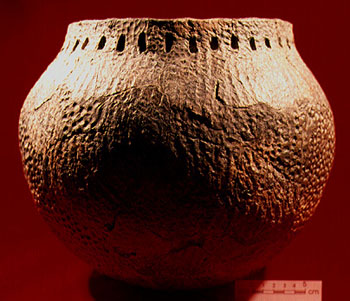
Exhibit Specimen 9
(ElKn-2)
 This is a large ceramic container of the Selkirk culture. In general shape, style and method of manufacture, this pottery type is closely related to Clearwater Lake Phase ceramics (see Exhibit Specimen 8).
This is a large ceramic container of the Selkirk culture. In general shape, style and method of manufacture, this pottery type is closely related to Clearwater Lake Phase ceramics (see Exhibit Specimen 8).
The exterior is roughened with coarse fabric or basket impressions. The vessel lip is plain. An encircling ring of deep, oval punctates is present at the base of the short, vertical neck which produced prominent interior bosses. The body is globular with a marked change in angle at the shoulder.
Selkirk ceramics have been found over an area just slightly smaller than Laurel pottery, from central Ontario across the top of Lake Superior and into the boreal forest of Manitoba and Saskatchewan. The Selkirk culture is a Late Woodland archaeological culture which began on the order of 1000 years ago and continued until contact with Euro-Canadians. The makers of Selkirk ceramics are believed to be the ancestors of various Cree groups.
This artifact was kindly made available for this exhibit by the Kenora Office of the Ontario Ministry of Culture, Citizenship and Recreation.
Further Reading
Lenius, B.J. and D.M.Olinyk
1990 The Rainy River Composite: Revisions to Late Woodland Taxonomy. In The Woodland Tradition in the Western Great Lakes: Papers Presented to Elden Johnson, edited by G.E. Gibbon. University of Minnesota, Publications in Anthropology No.4:77-112.
MacNeish, R.S.
1958 An Introduction to the Archaeology of Southeast Manitoba. National Museum of Canada, Bulletin 157, Ottawa.
Meyer, D. and D.Russell
1987 The Selkirk Composite of Central Canada: a Reconstruction. Arctic Anthropology 24(2):1-31.
Next
Previous
Back to the beginning